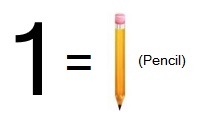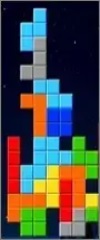- Home
- Better Memory
- Free Memory Tips
- January 2015 Issue
Free Memory Tips, January 2015 Issue
Below is the January 2015 issue of Free Memory Tips. To learn more about this free email newsletter, or to start receiving it, please visit the Subscription Page. I send out the newsletter about once a month. You can unsubscribe at any time.

Welcome to the JANUARY 2015 issue of my free Memory Tips email newsletter. Below are powerful strategies for improving your memory. Ready to boost your brain power?
Below are powerful strategies for improving your memory. Plus I've included links to free online brain games that can strengthen your thinking skills.
In this issue:
Memorization Pegs: The Number-Shape System
Suspect Alzheimer's? Try the Clock Draw Test
Block Blue Light at Night to Improve Sleep & Memory
FREE Brain Games: Improve VISUAL PERCEPTION Skills
If you like this newsletter, "pay it forward" by sending this to a friend. If someone did forward this to you, and if you like what you read, please subscribe by visiting the Memory Tips subscription page.
My goal is to help you learn faster and remember more. That's why I created Memory-Improvement-Tips.com and this email newsletter.
The secret to a more powerful brain is two-fold: 1) improve your brain health, and 2) learn memory techniques. This can lead to more success and fulfillment in life!
Memorization Pegs: The Number-Shape System
Need to memorize any type of factual list? Link mental images of the items you want to remember to a list you already know!

You might think you don't know any lists. But you do know how to count from 1 to 10.
That is a sequence of numbers in a particular order. It's a list, and you can peg to it any group of items you want to remember.
There are several number peg styles you can use, but the Number-Shape Peg memory system is an easy one to learn. When using this memory system, you recall the shape of the number as your image anchor.
Here's how the Number-Shape Peg system works. For 10 or fewer items, the goal is to mentally peg each item to one of the numbers from 1 to 10. You'll link a mental image of the item you want to remember to the anchor image of the number.
To prepare to use this memory system, first visualize your number anchors. Think of the shape of each number from 1 to 10. Then associate (mentally link) that shape in your mind with a real-world object that is similar in shape. This becomes your permanent number shape.
The image anchors I use are as follows:
Number 1 is a pencil;
Number 2 is a swan's neck;
Number 3 is the top of a love heart;
Number 4 is the sail on boat;
Number 5 is a hook;
Number 6 is a golf club;
Number 7 is a cliff's edge;
Number 8 is an hourglass;
Number 9 is a balloon on stick; and
Number 10 is a fork and plate.
These image anchors are based on the visual shape of the number. Feel free to use these same image anchors, or make up your own.
Number-Shape Peg Example. Suppose three items on my grocery list are oranges, milk, and bread. I don't have time to write them down, so I quickly create a mental Number-Shape Peg list.
It is important to make your mental images strange, impossible, and bizarre. The unusual is memorable.
Oranges: I imagine a gigantic orange pierced by 1,000 pencils.
Milk: I imagine a flock of swans struggling to swim in an ocean of white milk.
Bread: I imagine an enormous love heart being filled with loaves of bread.
At the store, recall is easy. I simply review my number pegs.
One - pencil. Oh, yes, the giant orange with pencils stuck into it. Buy oranges.
Two - swan. Oh yes, the flock of swans in milk. Buy milk.
Three - love heart. Oh yes, the giant love heart filling up with loaves of bread. Buy bread.

If this is the first time you've used the Number-Shape Peg system, mentally review the basic shapes (one - pencil, two - swan, three - love heart, etc.) a few times to become familiar with them. You should find them super easy to recall.
The same peg images can be used over and over for different lists, even at the same time. According to memory researchers, the brain can distinguish up to 6 different lists that use the same pegs at the same time.

If you need to memorize even more lists, there are other peg systems including Number-Rhyme Pegs, Alphabet-Concrete Pegs, and Alphabet Sound-Alike Pegs. These are also easy to learn.
Once the details you want to retain are consolidated in your long-term memory, the peg associations fade. The pegs aren't needed anymore, but the knowledge remains.
For important information, you can strengthen your long-term memory of the items even further by periodic review.
References:
1. Peg Systems for Remembeing Lists
2. Chapter 11: "Mental Filing Systems: Peg Mnemonic" in Your Memory: How It Works and How to Improve It, by Kenneth Higbee
Suspect Alzheimer's Dementia? Try the Clock Draw Test
Age-related memory loss resembles dementia but is considered relatively normal. In contrast, Alzheimer's dementia destroys brain cells and is fatal. Is there a simple way we can detect whether a forgetful friend or relative has dementia or normal memory loss?

The "clock draw" test is one such screening method. The test only requires a paper and pencil, and only takes a few minutes. Simply ask the person to draw the face of a clock from memory, showing 3:40 as the time.
At left is an example of a failed clock test, drawn by an actual patient with severe Alzheimer's. Due to his advanced dementia, it's immediately obvious his drawing doesn't look much like a clock.
An individual with normal cognitive function can do this easily. Everyone should be able to draw the round clock face, write the 12 hours in their correct positions, and draw the hour and minute hand.
A person affected by dementia, however, may have trouble reproducing parts of the clock.
A quick and easy dementia screening tool. Suppose you have a friend, uncle, or grandparent who is getting up in age. You've noticed they have become forgetful.
Not forgetful enough to interfere with daily life, but they sometimes grasp to recall basic knowledge such as the names of common objects or how to use the microwave oven.
If they are agreeable, have them try the clock draw test. Mistakes on their clock drawing such as the following may be a red flag:
Incomplete circle
Hours outside the circle
Incorrect time on the clock
Numbers on the left or right side of the clock only
Missing numbers
A well-drawn clock doesn't rule out dementia. Gross errors, though, indicate that a visit to a physician for a cognitive evaluation may be advisable.
References:
1. Alzheimer's Clock Draw Test - Detect the Signs of Alzheimer's Early
2. Surprising Natural Treatment for Alzheimer's: Coconut Oil
Block Blue Light at Night to Improve Sleep & Memory
Restful sleep is essential for optimum memory and concentration during the day. Exposure to blue light at night from computer screens, smart phones, TVs, fluorescent lights, and LED bulbs may be one reason you toss and turn in bed at night.

Perhaps surprisingly, the blue wavelengths emitted by these devices trick the mind into staying awake, even though you may want and need to go to sleep.
To fall asleep more easily, you could turn off all light sources at sunset. Or, you could filter out the blue light and continue to use the devices. Below I explain how to do this.
Why Blue Light Keeps You Awake
When all is well, our bodies follow a natural daily circadian rhythm. We feel sleepy at night and awake during the day. This is regulated by the hormone melatonin (known as the "darkness hormone"), secreted by the pineal gland in the brain.
When released into the body, melatonin helps you relax and fall into a deep and restful sleep. As night-shift workers know, the circadian rhythm can be disrupted. Short-circuiting melatonin interferes with sound sleep.
The type of light received by the eyes tells the body know whether it is day or night. Sunlight during the day is full-spectrum visible light. It contains red, yellow, green, blue, and other wavelengths (think rainbow).

Throughout history, at night people were exposed only to red-shifted visible light from fires, candles, and so on. Their eyes didn't see white, blue, or green wavelengths after dark.
Lack of exposure to blue light at night signals the body to naturally increase melatonin production and prepare our bodies and minds for sleep. But in our cleverness we have disrupted Nature's processes.
Our gadgets and technology have introduced blue wavelength light into the night.
"Light at night is part of the reason so many people don't get enough sleep." - Stephen Lockley, Harvard sleep researcher
It's not only blue bulbs that emit blue wavelengths. White and green light sources contain a high proportion of blue light.
If you use or are exposed to any of the following devices within an hour or two of bedtime, you may be setting yourself up for a restless night:
Computer screens - including laptops, desktops, tablets, and ebook readers
Television screens
Small white, blue, or green LED bulbs - such as on the front of VCRs, DVD players, digital clocks, cable boxes, internet routers
White, blue, or green neon lights - as found on clocks and signs
Fluorescent bulbs - including energy-saving bulbs
Sources that do not block melatonin production include candles, gas log fires, and red light bulbs. Traditional incandescent light bulbs don't emit much blue wavelength light, either.
You Can Still Use Some Electronics at Night
Most of us need to be able to check email, surf the web, and complete other electronic-related activities at night. Let me share some tricks for filtering out blue light.
Blue-blocking glasses. I have a pair of Blue Blockers that I put on most evenings at home an hour or so before going to bed. The glasses filter out blue wavelengths from all sources.
Turn off as many fluorescent lights as you can an hour or two before bedtime.
Install the Flux software on your computer and tablets. This wonderful, free program turns down the blue tones on your computer monitor at sunset. At sunrise, normal white light is restored on the screen automatically.
For your smart phone, install an app that filters out blue tones at night, similar to flux. For example, I have the free Twilight app configured on my Android phone. When I want to read a web article or check email on my phone late at night, blue wavelengths of light no longer shine in my eyes.
If you need a night light in your bedroom, choose one that emits red light.
Especially in the bedroom, use a digital alarm clock that displays red numbers, not blue.

Sleep experts agree it is best to turn off the television an hour or two before you want to fall asleep. Cognitive stimulation itself keeps the mind awake when we should instead be winding down for sleep.
A rested mind concentrates better during the day, and restful sleep energizes the body. And daytime learning consolidates to long-term memory during sleep.
On the other hand, inadequate sleep results in poor focus, physical tiredness, and memory lapses the following day.
Sure, it's unusual to wear sunglasses at night. And viewing a red-tinted computer screen after dark might take some getting used to. But if the quality and quantity of your sleep improves, you'll reap big benefits the next day from heightened focus and memory.
References:
1. Harvard Health Newsletter. "Blue Light Has a Dark Side." May 2012.
2. Psychology Today: Blocking Blue Light Helps Sleep
FREE Brain Games: VISUAL PERCEPTION
There are 255 free online brain games on my website, Memory-Improvement-Tips.com. You can play them online anytime. No restrictions, no logging in. Just pick a game, go to the game page, and start playing.
Below are links to three of the online games that train visual perception, a very important brain skill. Play them now to give your brain a boost.
Visual perception affects thinking speed and is related to other brain skills such as information processing and spatial orientation.
The RUN Game. This brain game, called simply the RUN Game, trains attention, spatial orientation, and reaction time skills. Run your character through a square shaped tunnel at high speed. But make sure to avoid the holes in the floor!
Snake Game. This free snake game is great for improving concentration. Lead your snake to the food pellets, but don't hit the obstacles! Keep your wits about you, because random "mystery pellets" shake things up every few minutes.
Shell Game. Here's the classic Shell Game. Few games beat this one for improving eye coordination and concentration. If you see this game being played on the street, it is often a swindle or confidence game. But here it's just a brain game played for fun.
That's all for now, and thanks for reading. For lots more tricks and strategies to improve your brain, visit the Get a Better Memory page on my website.
If you like the website, tell your friends and family about it. And please click the Facebook "Like" and Google +1 buttons on my site. Every vote of confidence helps. ![]()
Best regards,
Memory-Improvement-Tips.com
Home of over 200 free online brain games
Memory Tips newsletter Back Issues page: https://www.memory-improvement-tips.com/Free_Memory_Tips-backissues.html

Newest / Popular
Multiplayer
Board Games
Card & Tile
Concentration
Math / Memory
Puzzles A-M
Puzzles N-Z
Time Mgmt
Word Games
- Retro Flash -
Also:
Bubble Pop
• Solitaire
• Tetris
Checkers
• Mahjong Tiles
•Typing
No sign-up or log-in needed. Just go to a game page and start playing! ![]()
Free Printable Puzzles:
Sudoku • Crosswords • Word Search











